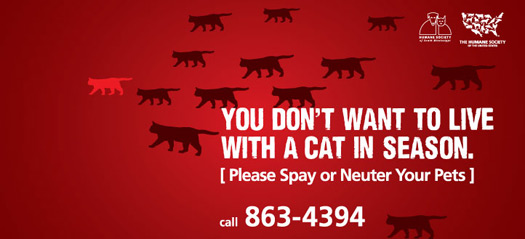
Billboard from Humane Society campaign launched in Louisiana and Mississippi, 2008. Design: pyperpaul + kenney
The greatness of a nation and its moral progress can be judged by the way its animals are treated. —Mahatma Gandhi
There’s little doubt that we Americans love our pets. According to the American Pet Products Association, we’ll spend an estimated $47.7 billion on our non-human dependants this year alone. And the growing marketplace of “designerly” pet products — showcased via equally designerly blogs (Moderncat and Dog-Milk, for example) — suggests that the design community is paying attention. Despite our obvious affection, though, we’re killing 3 to 4 million dogs and cats each year in shelters (a term that, in this light, seems like a cruel joke). Although a wide variety of underserved populations have benefited from the recent design-for-social-change movement, the pet (over)population remains largely ignored.
There are exceptions, of course — mostly in the form of awareness campaigns encouraging pet sterilization, and improved shelter environments.
In the past few years, spay/neutercampaigns have taken on an edgier, more sophisticated look and feel — reflecting a keen understanding of their audience. Employing compelling graphics and clever copy, these ads and posters recognize a profound truth, however unsettling: whether we’re promoting pet sterilization or adoption from shelters, in the end, success is still largely a matter of effective sales and marketing.
In some cases, it’s niche marketing. In 2008, the American Society for the Prevention of Cruelty to Animals (ASPCA) launched a campaign in which graffiti art was used to promote its mobile spay/neuter clinics. Working with the Tampa-based advertising agency pyperpaul+kenney, the ASPCA described its focus as “African-American and Hispanic inner-city male owners of large-breed dogs.”
Lori Weise, founder of the Downtown Dog Rescue, took on a similar challenge in South Central Los Angeles. She realized from the outset the importance of strong visual communication design. In order for her to connect with pit bull owners in the area — and persuade them to get their dogs altered — Weise needed to speak their (visual) language. She claims her ads and posters were among the first to feature photos of pit bulls (which L.A. Animal Services describes as “probably one of the most misunderstood breeds [with] the lowest adoption rate to prove it”) with “cropped” ears — “the breed standard in the hood,” she says—thus earning her credibility.
Other innovative examples:
> The Ad Council’s “Shelter Pet Project” sponsored by the Humane Society of the United States (HSUS) and Maddie's Fund
> Best Friends Animal Society’s “Puppies Aren’t Products” campaign
> The “Buy One, Get One Killed” video produced by People for the Ethical Treatment of Animals (PETA) as part of its Animal Birth Control campaign
A recent survey sponsored by PetSmart Charities indicates that only 24 percent of Americans acquire their pets from animal shelters or rescue organizations. The reasons are varied, but many can be linked to the shelter environment itself. Here, too, the design community is making important contributions, transforming shelters from traditional dark and dreary “storage facilities” to welcoming, even cozy, “adoption centers.”
Mike Arms, president of the Helen Woodward Animal Center, had radiant heating strategically located in the floors of the facility’s dog runs. Ordinarily, the dogs would hang out at the back of the runs, making it more difficult for the public to connect with them — and ultimately take one home. By heating the floors only in the areas nearest the steady flow of people, Arms ensures that the dogs are front and center — and getting adopted.
Cat Depot, located in Sarasota, Florida, is another organization with a user-friendly approach. No longer confined to cages, the cats are free to roam the “pods” and “suites” of their new 10,000-square-foot facility. And a state-of-the-art air filtration system keeps the facility fur- and dander-free, eliminates odors and helps to prevent the spread of airborne viruses and bacteria. Shelley Thayer, executive director of Cat Depot, says that, thanks to the new amenities, the organization is on track to double its 2009 adoption numbers this year.
One of the more interesting — and potentially lucrative — opportunities for product designers interested in reducing the number of unwanted pets lies in the field of non-surgical sterilization. The Michelson Prize in Reproductive Biology, a $25 million challenge akin to the X Prize, was established to provide a much-needed boost to a historically underfunded area of research. Another $50 million is being awarded as grants for supporting research.
Although the initial interest is likely to come from the white-lab-coat crowd, designers may soon get a piece of the action. According to its website, the Found Animals Foundation, which is administering the funds, “intends to pursue further development and commercialization activities as needed to bring the winning product or technology to market for use in cats and dogs.”
There’s no doubt that these efforts have saved — and will continue saving — the lives of many animals. Still, in each of these instances, the designers are, for the most part, playing supporting roles; their work is serving the client’s agenda. This, it seems to me, is a missed opportunity. The design community needs to be tackling this problem head-on.
Can we really “design” our way out of a problem so complex, so intractable? I’m suggesting that we can — though our success requires that we think of design in some rather broad terms. We need to approach the “unwanted pet” problem the way IDEO approached a similarly ambitious — and, as a design problem, unconventional — challenge: childhood obesity. Working with the Centers for Disease Control and Prevention, IDEO developed “Project Carrot,” a suite of concepts and prototypes “to address the ‘toxic food environment’ by promoting environmental, policy, and social change.”
Whether the problem is too many unwanted pets or too few adoptive homes, the cause of the problem is, at its root, human behavior. The way to turn the tide, then, begins with a deep understanding of the values, attitudes and beliefs that underlie those behaviors. And in this endeavor, quantitative studies take us only so far. Which is where ethnographic research — fast becoming a core skill for today’s designers — comes in.
Results of an extensive two-year study of spay/neuter decisions among pet owners in Louisiana and Mississippi illustrate the benefits of such methods. Published last year, the research — a collaborative effort of the HSUS, Priority Ventures Group, Greenberg Quinlan Rosner Research, illume Communications, and Maddie’s Fund — was prompted by the region’s alarming rate of unsterilized pets, a fact made clear in the aftermath of Hurricane Katrina. In addition to the telephone surveys typically used for such studies, the researchers conducted focus groups and in-depth interviews with owners of sterilized and non-sterilized pets. Among the more intriguing findings:
>Owners of unaltered pets love their pets, and consider themselves responsible pet owners. Campaigns that imply otherwise will likely be ignored.
>Pet owners may associate low-cost spay/neuter services with poor quality; establishing trust is critical for the success of such programs.
>Effective messages about spay/neutering demand a certain level of seriousness — cute visuals and celebrity spokespersons undermine the message.
The posters, billboards, television and radio spots developed as a result of this work reflect — however subtly — a deep understanding of their audience that is simply beyond the reach of typical “agree/disagree” surveys. And awareness campaigns are only the most obvious outcomes — the insights gained could, of course, be leveraged for a broad range of design solutions (e.g., in the case of low-cost spay/neuter clinics: everything from the environment itself to the record keeping system and attire worn by the staff).
In Change by Design, IDEO CEO Tim Brown calls for “an end to old ideas” by way of a new, more accessible and inclusive approach to innovation: design thinking. “The rise of design thinking corresponds to a culture change,” suggests Brown, “and what excites the best thinkers today is the challenge of applying their skills to problems that matter. Improving the lives of people in extreme need is near the top of that list.”
My challenge to the design community, then, is to ensure that saving the lives of our companion animals is near the top of that same list.


Comments [3]
08.13.10
10:25
This is a great challenge for the design community!
08.13.10
04:46
I think THIS kind of 20 something is the person ALL efforts should go to (and teens) to educate them about dogs, the work involved in training them so they get along with animals and people, and how any dog is best gotten from the shelter and NEVER a pet store. But, not until you own a home, with a yard, can walk the dog every day (twice for some breeds) in rain, sun, or snow and, understand that vet bills for a dog add up to thousands of dollars over its whole live. Frankly, enough to buy a really nice car, vacation overseas every few years (no matter your income), pay for your child's college, retire with more money, etc. Dogs are now EXPENSIVE over the decades you will be responsible for one.
08.13.10
11:18